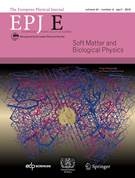May 23 2018
In the human body, the transport of molecules through channels is vital for various phenomena such as the transfer of genetic information, synthesis and the degradation of biomolecules, and viral infections and protein trafficking.
 (Image credit: Springer)
(Image credit: Springer)
Improvement in the ability to control these channels and the potential of molecules to pass through could lead to various prospective applications in the areas of biotechnology, energy, and medicine. These include protein folding, detection of biological markers used in disease diagnostics, ultra-fast DNA sequencing, high-resolution determination of the size of biological molecules, or even the control of biomolecule or ion transport through the protein sensor.
In an innovative research reported in EPJ E, Manuela Pastoriza-Gallego from the University Paris-Seine, France, and her team have demonstrated ways to modify external factors (e.g. external voltage) to regulate the transport of a dextran sulfate molecule, a polyelectrolyte, through the nanopores of the aerolysin protein channel.
The molecules that pass through such biological channels are, in general, formed of a chain of atoms, which might be larger than the pore diameter, usually having a width smaller than 2 nm and length smaller than 10 nm. This indicates that a driving force is needed to overcome the energy barrier of the channel that restricts the chain of atoms to the nanopore. Molecule-pore interactions also govern the level of this energy barrier. Earlier, the researchers analyzed studied a different nanopore, known as alpha-hemolysin.
Researchers rely on electrical detection for the analysis of the dynamics in restricted medium at the single-molecule level. They have recognized the effect of partially folded protein chains when they pass through the channel, which results in very long blockades in nanopores. They have taken cues from their earlier study on alpha-hemolysin nanopores to prove that protein unfolding transition is not dependent on the nanopore that is used.
In the case of completely unfolded protein, they have shown that the ingress into the pore must overcome a minimum energy barrier. They have also demonstrated that the time to transport decreases exponentially with respect to the applied voltage and increases with respect to the length of the protein chain.